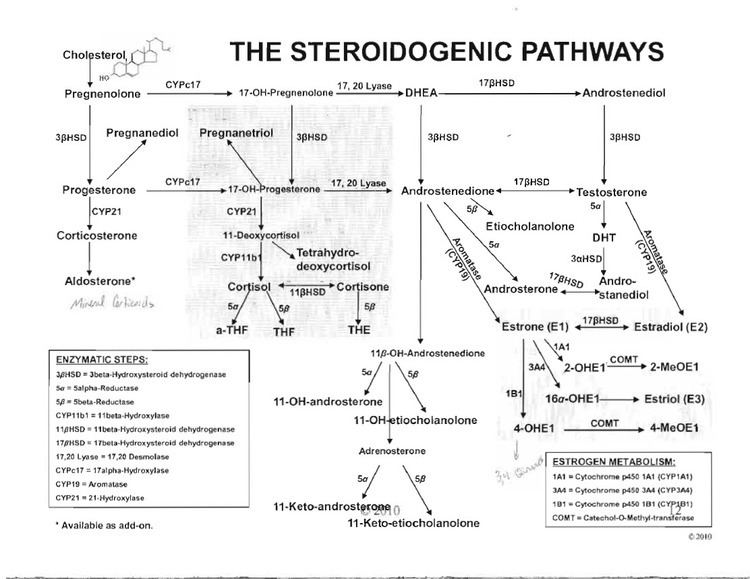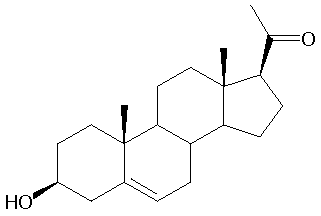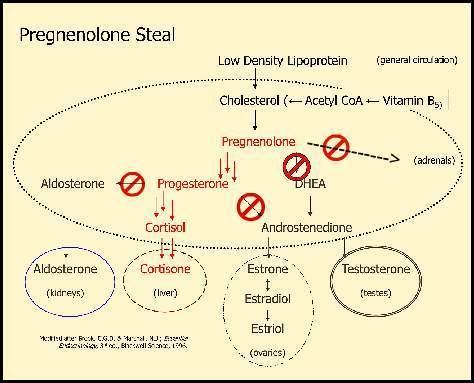Routes ofadministration Oral, transdermal CAS Number 145-13-1 Formula C21H32O2 CAS ID 145-13-1 | ATC code None PubChem CID 8955 Molar mass 316.4776 g/mol | |
 | ||
AHFS/Drugs.com International Drug Names Legal status In general: Over-the-counter (OTC) | ||
Pregnenolone the mother of steroid hormones
Pregnenolone (P5), or pregn-5-en-3β-ol-20-one, is an endogenous steroid and precursor/metabolic intermediate in the biosynthesis of most of the steroid hormones, including the progestogens, androgens, estrogens, glucocorticoids, and mineralocorticoids. In addition, pregnenolone is biologically active in its own right, acting as a neurosteroid.
Contents
- Pregnenolone the mother of steroid hormones
- Pregnenolone the master hormone
- Biosynthesis
- Metabolism
- Neurosteroid activity
- Microtubule associated protein 2
- Nuclear receptors
- Pharmacology
- Chemistry
- Derivatives
- Brand names
- References

Pregnenolone the master hormone
Biosynthesis

Pregnenolone is synthesized from cholesterol. This conversion involves hydroxylation of the side chain at the C20 and C22 positions, with cleavage of the side chain. The enzyme performing this task is cytochrome P450scc, located in the mitochondria, and controlled by anterior pituitary trophic hormones, such as adrenocorticotropic hormone, follicle-stimulating hormone, and luteinizing hormone, in the adrenal glands and gonads. There are two intermediates in the transformation of cholesterol into pregnenolone, 22R-hydroxycholesterol and 20α,22R-dihydroxycholesterol, and all three steps in the transformation are catalyzed by P450scc.

To assay conversion of cholesterol to pregnenolone, radiolabelled cholesterol has been used. Pregnenolone product can be separated from cholesterol substrate using Sephadex LH-20 minicolumns.
Pregnenolone is produced mainly in the gonads, adrenal glands, and the brain.
Metabolism
Pregnenolone undergoes further steroid metabolism in one of several ways:
Neurosteroid activity

Pregnenolone and its 3β-sulfate, pregnenolone sulfate, like DHEA, DHEA sulfate, and progesterone, belong to the group of neurosteroids that are found in high concentrations in certain areas of the brain, and are synthesized there. Neurosteroids affect synaptic functioning, are neuroprotective, and enhance myelinization. Pregnenolone and its sulfate ester are under investigation for their potential to improve cognitive and memory functioning. Pregnenolone is also being considered as a potential treatment for schizophrenia.

Although pregnenolone itself does not possess these activities, its metabolite pregnenolone sulfate is a negative allosteric modulator of the GABAA receptor as well as a positive allosteric modulator of the NMDA receptor. In addition, pregnenolone sulfate has been shown to activate the transient receptor potential M3 (TRPM3) ion channel in hepatocytes and pancreatic islets causing calcium entry and subsequent insulin release.

Pregnenolone is involved in a natural negative feedback loop against CB1 receptor activation in animals. It prevents CB1 receptor agonists like tetrahydrocannabinol, the main active constituent in cannabis, from fully activating the CB1
Microtubule-associated protein 2
Pregnenolone has been found to bind with high, nanomolar affinity to microtubule-associated protein 2 (MAP2) in the brain. In contrast to pregnenolone, pregnenolone sulfate did not bind to microtubules. However, progesterone did and with similar affinity to pregnenolone, although unlike pregnenolone, it did not increase binding of MAP2 to tubulin. Pregnenolone was found to induce tubule polymerization in neuronal cultures and to increase neurite growth in PC12 cells treated with nerve growth factor. As such, pregnenolone may control formation and stabilization of microtubules in neurons and may affect both neural development during prenatal development and neural plasticity during aging. The 3β-methyl ether of pregnenolone, 3β-methoxypregnenolone (MAP-4343), retains similar activity to pregnenolone in regards to interaction with MAP2, and is under development for potential clinical use for indications such as the treatment of brain and spinal cord injury and depressive disorders.
Nuclear receptors
Pregnenolone has been found to act as an agonist of the pregnane X receptor.
Pharmacology
Oral administration of 50 or 100 mg pregnenolone has been found to have minimal or negligible effect on urinary levels of testosterone and testosterone metabolites, including of androsterone, etiocholanolone, 5β-androstanediol, androstadienol, and androstenol (and/or their conjugates), and this suggests that only a small amount of pregnenolone is converted into testosterone. This is in accordance with findings on the conversion of DHEA into testosterone, in which only 1.5% of an oral dose of DHEA was found to be converted into testosterone. In contrast to the androstanes, 50 or 100 mg oral pregnenolone has been found to significantly and in fact "strongly" increase urinary levels of the progesterone metabolites pregnanediol and pregnanolone (and/or their conjugates), whereas pregnanetriol was unaffected. Unlike the case of oral administration, transdermal administration of 30 mg/day pregnenolone cream has not been found to affect urinary levels of metabolites of any other steroids, including of progesterone.
Sripada et al. reported that oral pregnenolone is preferentially metabolized into the neurosteroid allopregnanolone rather than into other steroids such as DHEA or cortisol. In further research by their group, a single 400 mg dose of oral pregnenolone at 3 hours post-administration was found to result in a 3-fold elevation in serum levels of pregnenolone and a 7-fold increase in allopregnanolone levels. Pregnanolone levels increased by approximately 60% while DHEA levels decreased non-significantly by approximately 5% and cortisol levels were not affected. Another study found that allopregnanolone levels were increased by 3-fold at 2 hours post-administration following a single 400 mg oral dose of pregnenolone.
In addition to allopregnanolone, exogenous pregnenolone also functions as a prohormone of pregnenolone sulfate.
Pregnenolone is lipophilic and readily crosses the blood-brain-barrier.
Chemistry
Pregnenolone is also known chemically as pregn-5-en-3β-ol-20-one. Like other steroids, it consists of four interconnected cyclic hydrocarbons. The compound contains ketone and hydroxyl functional groups, two methyl branches, and a double bond at C5, in the B cyclic hydrocarbon ring. Like many steroid hormones, it is hydrophobic. The sulfated derivative, pregnenolone sulfate, is water-soluble.
3β-Dihydroprogesterone (pregn-4-en-3β-ol-20-one) is an isomer of pregnenolone in which the C5 double bond has been replaced with a C4 double bond.
Derivatives
A few synthetic ester derivatives of pregnenolone exist. These include pregnenolone acetate (Antofin, Previsone, Pregno-Pan) and pregnenolone succinate (Panzalone, Formula 405). Prebediolone acetate (Acetoxanon, Acetoxy-Prenolon, Artisone, Artivis, Pregnartrone, Sterosone), the 21-acetate ester of 21-hydroxypregnenolone, also exists. These esters are all described as glucocorticoids similarly to pregnenolone.
Brand names
Pregnenolone is or has been marketed as a pharmaceutical drug in some countries. Brand names of pregnenolone have included Arthenolone, Bina-Skin, Enelone, Natolone, Pregnetan, Pregneton, Pregnolon, Prenolon, Regnosone, Sharmone, and Skinostelon. It is described in the context of medical use as an "adrenal cortex hormone" or a glucocorticoid for the treatment of rheumatoid arthritis.
